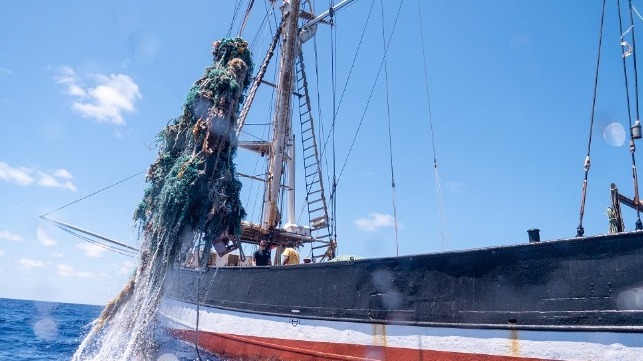Sailing Ship Sets Marine Plastic Recovery Record

The motor-sailing cargo ship Kwai docked Tuesday at the port of Honolulu, bringing home a catch of more than 100 tons of fishing nets and consumer plastic from the Great Pacific Garbage Patch (also known as the Gyre). It represents the largest single cleanup at sea in the Gyre to date, and it is more than twice the Kwai's haul from last year.
When the Kwai arrived in Honolulu, she completed a 48-day at sea clean-up mission that began at Hilo on May 4. She only got under way after a three week self- imposed quarantine period to ensure the health of crew members during the COVID-19 pandemic.
During the expedition, Kwai's crew collected waste with the help of specialized GPS satellite trackers, which were previously attached to drifting nets by volunteer yachts and ships. The ocean often sorts debris, so a tagged fishing net can lead to other nets and a density of debris. Drones and lookouts help the ship’s crew to hone in on the debris. They recover the litter, bag it and store it in the ship’s cargo hold for later recycling and repurposing.
“I am so proud of our hard working crew,” says Mary Crowley, founder and executive director of the Kwai's charterer, the Ocean Voyages Institute. “Ocean Voyages Institute has been a leader in researching and accomplishing ocean clean-up for over a decade - granted with less fanfare and attention than others, but with passion and commitment and making meaningful impacts.”
The Kwai's crew unloaded the record-breaking haul at Honolulu's Pier 29 with the support of Honolulu-based Matson. “In keeping with our commitment to environmental stewardship, Matson has been searching for a way to get involved in cleaning up the Pacific Gyre,” said Matt Cox, chairman and CEO. “We’ve been impressed with the groundbreaking efforts of Ocean Voyages Institute and the progress they’ve made with such a small organization, and we hope our support will help them continue this important work.”
The Kwai and Ocean Voyages Institute are planning a second voyage to the Gyre departing the end of June. The length of a second summer leg will be determined by how successful Ocean Voyages Institute is in securing additional donations. “Our solutions are scalable, and next year, we could have three vessels operating in the North Pacific Gyre for three months, all bringing in large cargoes of debris,” says Crowley. “We are aiming to expand to other parts of the world desperately needing efficient clean-up technologies. There is no doubt in my mind that our work is making the oceans healthier for the planet and safer for marine wildlife, as these nets will never again entangle or harm a whale, dolphin, turtle or reefs.”
